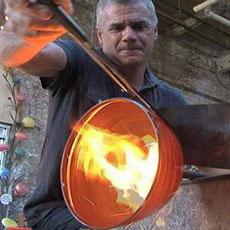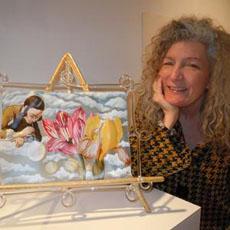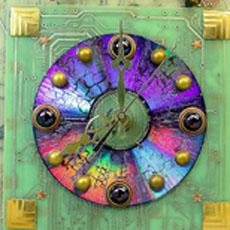
FAITH LAPIDUS: Welcome to THIS IS AMERICA in VOA Special English. I'm Faith Lapidus.
JUNE SIMMS: And I'm June Simms. This week, we learn about three American artists and their work. And later, we leave the art world to tell about a new exhibit at the American Museum of Natural History in New York City.
(MUSIC)
FAITH LAPIDUS: Anthony Corradetti works with hot, molten glass at a studio in Baltimore, Maryland. He shapes glass in the same way glass blowers before him have done for centuries. But he is not making common household objects. Instead, he is creating works of art.
Glass blowing dates back more than 2,000 years. Researchers have found evidence of glass blowing by the first European settlers to North America in the early 1600s.
Anthony Corradetti says glass blowing has grown in popularity in the United States over the past 50 years.
ANTHONY CORRADETTI: "It was kind of a field that got taken over by industry. And they need less glass blowers because everything was made by machines. But in the late 1960s or early 1970s, people started treating it more as an art form and teaching it in art schools. And now there are just some amazing things being made out of glass in small studios, such as mine, all over the country."
JUNE SIMMS: The first step of glass blowing is to collect the molten glass on the end of a hollow piece of steel, called a blowpipe. Water is used to cool down the glass.

The object is shaped as air pressure expands the ball of hot glass. Sometimes different colors are added and the object is reheated, with temperatures reaching more than 1,200 degrees Celsius. Next, the completed piece is separated from the blowpipe. Finally, it is placed in an oven for 24 to 48 hours to keep it from cooling too quickly and breaking.
FAITH LAPIDUS: The process may seem simple. But Anthony Corradetti says it takes a lot of attention and hard work. He says glass blowing is always a crowd-pleaser.
ANTHONY CORRADETTI: "People are really interested in glassblowing. It's a kind of thing that everybody has seen it as a child somewhere, and it leaves a big impression. Because when you watch glassblowing, it's kind of magical. It's the kind of thing that everybody wants to try once in their life."
Mr. Corradetti offers glass blowing classes. He also sells his own work in the studio's gift shop. After more than 30 years as a glass artist, he says he still enjoys what he does.
ANTHONY CORRADETTI: "I like everything about it, the heat and just everything that goes along with making glass. The tools and the sounds and the smells and everything about it ... I couldn't do anything else."
To see Anthony Corradetti in action, watch a video on our website, voaspecialenglish.com.
(MUSIC)
JUNE SIMMS: Ginny Ruffner is one of the best-known glass artists in the United States. Her one-of-a-kind pieces are colorful, detailed and often humorous. Over the years, she became famous for a method called lamp working, also known as flame working. It involves using a torch to melt and shape the glass instead of blowing on it.
Ginny Ruffner almost died in a three-car accident in 1991. No one thought the Seattle-based artist would ever walk or talk again. An award-winning film documentary explores that period of her life.
GINNY RUFFNER: "It's scary when you can't talk, you can't do... all your life."
FAITH LAPIDUS: Ms. Ruffner was in a coma for five weeks and a wheelchair for five years. But she overcame her injuries. And although she still has difficulty walking and talking, she has willed herself back to work. Now, she has a team that helps bring her dream to life.
Her team recently finished an 8.5 meter-high flowerpot made of steel and aluminum. It is now in downtown Seattle. Ms. Ruffner was recently honored in Washington, DC. The Renwick Gallery presented a special showing of the film, "A Not So Still Life, the Ginny Ruffner Story."
JUNE SIMMS: Ms. Ruffner says it has been a long battle, but the hardest part has not been the physical problems.

GINNY RUFFNER: "I detest being taken for granted. Being ignored. The way I talk, people assume that I'm either really old, or kind of retarded, and that is so frustrating."
But she is firm.
GINNY RUFFNER: "Fortunately I've done a lot of stuff in my life, so I know that the best thing is to be open to the mystery, who knows what great things will happen. I'm sure they're many more to come."
Ginny Ruffner's art can be seen in more than 40 museums around the world. Her work and her life continue to motivate people of all ages. To watch a video about the artist, visit voaspecialenglish.com.
(MUSIC)
FAITH LAPIDUS: It is often said that one person's trash is another person's treasure. That is true for Debby and Joel Arem of Gaithersburg, Maryland. Twenty years ago, they started creating jewelry and office products from old, recycled computer circuit boards. Today, they have plenty of "green," environmentally-friendly products.
There is no shortage of recycled material for Debby Arem's creations. She uses everything, from pieces of metal and electronic parts, to computer circuit boards and chips.
DEBBY AREM: "In 1992, my husband had a company that made computers. And I saw a circuit board for the very first time in my life and I went out of my mind. I said that is the most beautiful thing I have ever seen with all the intricate circuitry and the colors. And the first thing that came to my mind was you could make jewelry out of that."
JUNE SIMMS: Debby Arem has a college degree in fine arts. She and her husband Joel formed a company called Three Ring Circuits and began offering their jewelry and other products at a local craft show.
DEBBY AREM: "The first night we sold out of our clipboards, completely sold out. People would come by the booth and do a double take and they would say, that is a circuit board from a computer? Oh, what a clever idea."
The number of products has grown. The Arems use unwanted prototype circuit boards in almost everything they make. Then they add colorful old beads, small pieces of metal, and anything else they find interesting.
DEBBY AREM: "If I hadn't rescued them or if we hadn't rescued the circuit boards from these companies, they would have ended up potentially in a landfill or had been burned."
Circuit boards recovered from telephones are popular.

DEBBY AREM: "I come up with ideas many times but I can't quite figure out how to engineer it. And Joel is a master at taking an idea that I come up with and figuring out how to actually put it together."
FAITH LAPIDUS: Debby and Joel Arem say working together for 20 years has strengthened their marriage.
JOEL AREM: "You get to know a person a lot better when you spend that much time and overcoming not only the challenges of the relationship but the stress of business really puts the strain on a relationship. If you can get through it, it [marriage] gets stronger."
DEBBY AREM: "We have a lot of fun, we really do. I don't consider this work. That's the best part of it."
Now, instead of traveling to craft shows, the Arems use the Internet to sell their artwork. That way they can spend more time in their home studio, meeting the increasing demand from around the world for the creations.
(MUSIC)
JUNE SIMMS: Living things of all kinds have qualities that help them to survive. One example is the ability of some animals to create light to find food, or avoid being eaten or, in some cases, to identify a mate. A new exhibit in New York explores this ability, known as bioluminescence. The exhibit, called "Creatures of Light," can be seen at the American Museum of Natural History. It shows jellyfish that produce a greenish light or glow. It also includes anglerfish whose lantern-like lights hang from their foreheads.
Museum Provost Michael Novacek says he is interested in the bioluminescent creatures that live deep in the ocean.
MICHAEL NOVACEK: "They are probably the most inventive of the bioluminescent creatures because they have to be. Because it's totally dark. So that's probably where the greatest potential for discovery is, too. There are so many things down there we haven't even described."
FAITH LAPIDUS: Surprisingly, up to 90 percent of the areas where living things can survive is underwater. Most of the animals that live in the water below depths of 700 meters are bioluminescent. That is where the anglerfish and hatchetfish live.
John Sparks organized the exhibit. Mr. Sparks is a marine biologist who specializes in pony fish, which live closer to the surface. They can give off light during the daytime that appears similar to their surroundings. This makes them extremely difficult for other fish to see.
JUNE SIMMS: Many bioluminescent animals use light to trick other creatures. The glowing shape on the underbelly of the large cookie cutter shark, for example, looks like the sun or moonlight on the surface of the water. From below, other creatures can mistake the small dark areas between the shark's lights for small fish. When an attacking fish moves in for what it thinks will be a quick meal, it can become a meal for the shark instead.
The show also includes some of the many bioluminescent organisms that live on land. The "Creatures of Light" exhibit continues at the American Museum of Natural History in New York until early next year.
(MUSIC)
FAITH LAPIDUS: Our program was produced by Mario Ritter, with reporting by Medeeha Anwar, Julie Taboh, June Soh and Adam Phillips. I'm Faith Lapidus.
JUNE SIMMS: And I'm June Simms. Join us again next week for THIS IS AMERICA in VOA Special English.
molten glass: 玻璃液,熔化玻璃
bioluminescent: (of living organisms) emitting light 生物性发光的
Artists paint the town in Baltimore
Nam June Paik made video into a modern art form
A look into the life, music and art of American Indians
Six building designers who are redefining modern architecture
(来源:VOA 编辑:旭燕)
关注和订阅


电话:8610-84883645
传真:8610-84883500
Email: languagetips@chinadaily.com.cn